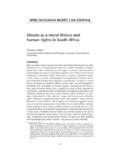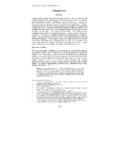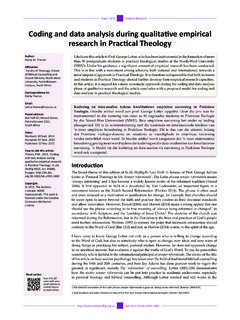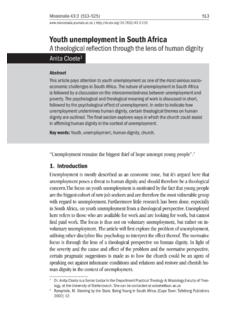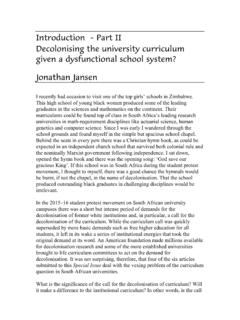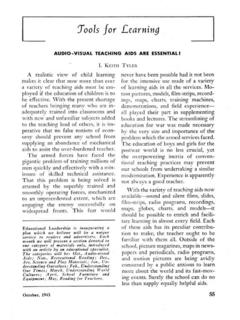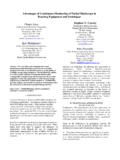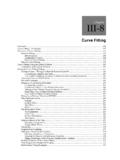Transcription of AN INTRODUCTION TO SOUTH AFRICAN LAW REPORTS …
1 106 Fundamina 19 (1) 2013 ISSN: Print 1021-545X Unisa Press pp AN INTRODUCTION TO SOUTH AFRICAN LAW REPORTS AND reporters , 1828 to 1910JP van Niekerk1 BackgroundJudicial decisions, as any first year law student knows, are one of the fundamental sources of our law. Yet court decisions can only effectively be a source of law if they are accessible, if not to the public at large, then at least to the members of the legal profession. Without accessible records of court decisions, and, of course, an established hierarchy of courts, the doctrine of stare decisis or judicial precedent, even in the somewhat watered down and flexible version that applies in SOUTH AFRICAN law,1 would not function properly, if it did so at The main advantages of the doctrine legal certainty, predictability of the outcome of litigation, the protection of vested rights, and uniformity and equality in the application of legal principles would consequently be , then.
2 Are judicial decisions best made accessible? They are disseminated by publication. And historically the primary form of publication has been the law report , in which are collected the reasoned judicial decisions 1 In English law, the peculiar feature of the doctrine of precedent is said to be its strongly coercive nature , resulting in English judges occasionally being obliged to follow a previous decision although they may have what would otherwise be good reasons for not doing so: Rupert Cross & JW Harris Precedent in English Law 4 ed (Oxford, 1991) at On judicial precedent, see generally HR Hahlo & Ellison Kahn The Union of SOUTH Africa.
3 The Development of Its Laws and Constitution (London, 1960) at 29-35; HR Hahlo & Ellison Kahn The SOUTH AFRICAN Legal System and Its Background (Cape Town, 1968) (hereafter Hahlo & Kahn SA Legal System) at 214-216, 226-231, 244-282; Ellison Kahn The rules of precedent applied in SOUTH AFRICAN courts (1967) 84 SALJ 43-55, 175-193, 308-330; and on the development of the doctrine of stare decisis in England, see T Ellis Lewis The history of judicial precedent (1930) 46 LQR 207-224, 341-360, (1931) 47 LQR 411-427, (1932) 48 LQR 230-247.
4 ** Professor, Department of Mercantile Law, School of Law, University of SOUTH Africa. I should like to thank my research assistant, Evelyn Edwards, for her perseverance in tracing, copying and scanning the materials necessary to write this piece, and my colleague Heinrich Schulze for snapping away on my behalf while he could have stood in awe of Hoeri 145 107 INTRODUCTION TO SOUTH AFRICAN LAW REPORTS AND REPORTERSof the various So, it has been said, the law is found written and recorded in the law REPORTS .
5 [and the] law REPORTS .. are the public record of the use and practice of legal principles, having recorded the decisions, actions and opinions of those most extensively involved on a daily basis with all segments of it .4 Today law REPORTS have become an indispensable element in the dissemination of our case REPORTS are, of course, well known in English law, and their format in that system has been largely adopted in SOUTH Africa as it has in other legal systems influenced by the common practice of law reporting in English law dates from at least the thirteenth century,7 when the REPORTS were mainly tools for the training of lawyers.
6 At first in the form of manuscript collections of decisions taken down by apprentice lawyers or scribes, known as Year Books,8 the REPORTS later, from the sixteenth century onwards, increasingly took the form of private collections of REPORTS by individual law reporters published on their own initiative. These nominate or named REPORTS , currently taken up in the massive 178-volume series entitled English Reports9 and also available online, 3 At various stages in the past, newspapers, too, played a role in the publication of judicial decisions.
7 However, newspaper REPORTS were (and are) generally unofficial and often unreliable since they are produced by journalists without any background in law. That largely diminishes their importance and value for legal practitioners. Still, they remain an important if generally undervalued source for legal historical research: see, generally, James Oldham Law reporting in the London newspapers, 1756-1786 (1987) 31 American J of Legal History 177-206; Jeremy Patrick Beyond case reporters : Using newspapers to supplement the legal-historical record (A case study of blasphemous libel) (2011) 3 Drexel LR Gerald J Postema Roots of our notion of precedent in Laurence Goldstein (ed) Precedent in Law (Oxford, 1987) 9-34 at Whether they will remain so is another matter, though.
8 The hard-copy law report seems to be on the verge of extinction, about to be overtaken by online versions of judicial See, eg, William Holdsworth Law reporting in the nineteenth and twentieth centuries 1941 Anglo-American Legal History Series (Series 1, no 5) (New York, 1941); Thomas J Young A look at American law reporting in the 19th century (1975) 68 Law Library J 294-306; Susan Barker Law reporting in England and the United States: History, controversy and access to justice (2007) 32 Canadian Law Library Rev 178-183; Peter Spiller The development of law reporting in New Zealand 1994 New Zealand LJ 75-79.
9 See also generally Chantal Stebbings (ed) Law Reporting in Britain (London, 1995).7 On the history of law reporting in England, see, eg, WTS Daniel The History and Origin of the Law REPORTS (London, 1884); Frank Pegues The medieval origins of modern law reporting (1953) 38 Cornell Law Quarterly These continue to be edited, reprinted and published under the auspices of the Selden Cases reported there are referred to as follows: Biccard v Shepherd (1861) 14 Moo PCC 471, 15 ER 383. Moo PCC is the abbreviation for the REPORTS of Privy Council Cases 1836-1862 compiled and published by Edmund F Moore, ER the abbreviation of the English REPORTS .
10 Since the original report is in all probability no longer accessible to the modern researcher, it has become necessary to add a reference to the reproduced version in the English REPORTS as well. One sure reason to suspect that students and researchers have not consulted old English cases at first hand is an absence of any reference to the English REPORTS . The decision referred to earlier concerned an appeal from the Cape Supreme Court (in Namaqua Mining Co v Commercial Marine & Fire Insurance Co (1859) 3 Searle 231) and the Privy Council decision was also reported locally: (1861) 3 Searle 242 (PC).
